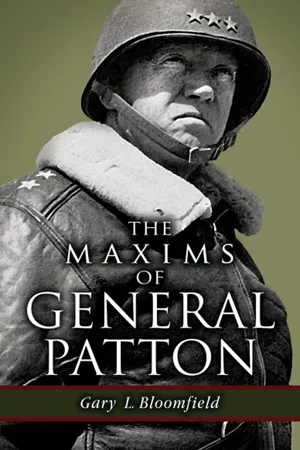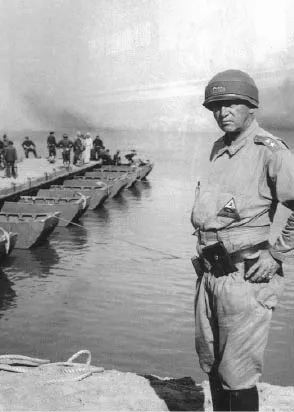
This is a test
- 128 pages
- English
- ePUB (mobile friendly)
- Available on iOS & Android
eBook - ePub
The Maxims of General Patton
Book details
Book preview
Table of contents
Citations
About This Book
Journal entries, speeches, quotes, and more that reveal a new side of this WWII military icon, with period photos included. Gen. George S. Patton was one of the most tenacious, unstoppable players in the United States' European Campaign of World War II. Few know that beneath his tough and sometimes controversial public image was a man of complexity who competed as an Olympic athlete and wrote poetry. The contemplative side of this dynamic man is displayed in this collection of poems, journal entries, quotations, and speeches. This in-depth journey through the mind of a truly remarkable American is accompanied by period photographs, and reveals new dimensions of the renowned commander.
Frequently asked questions
At the moment all of our mobile-responsive ePub books are available to download via the app. Most of our PDFs are also available to download and we're working on making the final remaining ones downloadable now. Learn more here.
Both plans give you full access to the library and all of Perlego’s features. The only differences are the price and subscription period: With the annual plan you’ll save around 30% compared to 12 months on the monthly plan.
We are an online textbook subscription service, where you can get access to an entire online library for less than the price of a single book per month. With over 1 million books across 1000+ topics, we’ve got you covered! Learn more here.
Look out for the read-aloud symbol on your next book to see if you can listen to it. The read-aloud tool reads text aloud for you, highlighting the text as it is being read. You can pause it, speed it up and slow it down. Learn more here.
Yes, you can access The Maxims of General Patton by Gary L. Bloomfield in PDF and/or ePUB format, as well as other popular books in Historia & Biografías militares. We have over one million books available in our catalogue for you to explore.
Information
Topic
HistoriaSubtopic
Biografías militares
As commander of the Second Armored Division, Maj. Gen. George Patton drilled his soldiers, preparing them for a war already escalating in Europe. During the Louisiana Maneuvers in 1941, he oversaw a company of combat engineers as they assembled a pontoon bridge. (Patton Museum)
Chapter 1
On Training and Technology
George Patton was a taskmaster, pushing his men to exhaustion day after day in simulated combat exercises, long before they ever felt the sting of battle. He knew that working together as a cohesive unit during war games in the States would lead to fewer casualties on the killing fields somewhere overseas. He preached “more sweat, less blood.”
Some couldn’t cut it, and many cursed his name, but he knew how important it was to sharpen the spear to a razor’s edge. Every soldier needed to know his role as part of a formidable fighting force. That force had yet to experience the brutal ugliness of combat, but Patton was confident that, once thrown into the fire, it would quickly become an unstoppable blaze of American might.
By studying advances in weaponry and war fighting, by absorbing the writings of other combat tacticians such as Sun Tzu and Clausewitz—whose ideas of warfare clashed with his own views—Patton envisioned a fast-moving strike capability, as yet untested in combat . . . that is until July of 1936, when Nazi Germany sent the combined air and ground forces of the Condor Legion to Spain, fighting alongside the Nationalists in that country’s civil war. The Nazis had unleashed their own form of this lightning warfare, known as the blitzkrieg. Reading news reports of this devastating and formidable combined arms force, Patton knew this would be the future of warfare, and he would be America’s main proponent, despite overwhelming criticism from his army contemporaries.

“The purposes of discipline and training are:
“1. To ensure obedience and orderly movement.
“2. To produce synthetic courage.
“3. To provide methods of combat.
“4. To prevent or delay the breakdown of the first three due to the excitement of battle.
“The Americans as a race are the greatest mechanic in the world. America as a nation has the greatest ability for mass production of machines. It therefore behooves us to devise methods of war which exploit our inherent superiority. We must fight the war by machines on the ground and in the air to the maximum of our ability.” ~ Journal entry.

“Battle is an orgy of disorder. No level lawn nor marker flags exist to aid us in strutting ourselves in vain display, but rather groups of weary, wandering men seeking gropingly for means to kill their foes. The sudden change from accustomed order to utter disorder, to chaos, but emphasizes the folly of schooling to precision and obedience where only fierceness and habituated disorder are useful.”

“When man first began fighting man, he unquestionably used his teeth, toenails and fingernails. Then one day a very terrified or else very inventive genius picked up a rock and bashed a man in the head while he was gnawing at his vitals. The news of this unheard-of weapon unquestionably shocked Neolithic Society, but they became accustomed to it. Thousands of years later, another genius picked up the splintered rib of a Mastodon and using it as a dagger, thrust it into the gentleman with a rock in his hand. Again, pre-historic society was shocked and said, ‘There will surely be no more wars. Did you hear about the Mastodon bone?’ When the shield, slingshot, javelin and the sword and armor were successively invented, each in its turn was heralded by the proponents as a means of destroying the world or of stopping war.”

“Do not regard what you do only as ‘preparation’ for doing the same thing more fully or better at some later time. Nothing is ever done twice. There is no next time. This is of special application to war. There is but one time to win a battle or a campaign. It must be won the first time.”

“History is replete with accounts of military inventions, each heralded by its disciples as the ‘Dernier Cri’—the ‘Key’ to victory.”

“It is the common experience of mankind that in moments of great excitement the conscious mental processes of the brain no longer operate. All actions are subconscious, the result of habits. Troops whose training and discipline depend on conscious thought become helpless crowds in battle. To send forth such men is murder. Hence, in creating an Army, we must strive at the production of soldiers, so trained that in the midst of battle they will still function.”

“If brevity is the soul of wit, then repetition is the heart of instruction.”

“Today, machines hold the place formally [formerly] occupied by the jawbone of an ass, elephant, armor, longbow, gunpowder, and submarine. They, too, shall pass.”

“Certainly, the advent of the atomic bomb was not half as startling as the initial appearance of gunpowder. In my own lifetime, I can remember two inventions, or possibly three, which were supposed to stop war; namely the dynamite cruiser ‘Vesuvius,’ the submarine and the tank. Yet, wars go blithely on and will still go on when your great-grandchildren are very old men.”

“When the great day of battle comes, remember your training, and remember, above all, that speed and vigor of attack are the sure roads to success and that you must succeed. To retreat is as cowardly as it is fatal.” ~ Journal entry after Operation Torch, the invasion of North Africa, November 3, 1942.

“It is very easy for ignorant people to think that success in war may be gained by the use of some wonderful invention rather than by hard fighting and superior leadership.”
...
Table of contents
- Contents
- Acknowledgments
- Introduction
- Chapter 1: On Training and Technology
- Chapter 2: On Pride, Discipline, and Confidence
- Chapter 3: Patton’s Fury
- Chapter 4: On Teamwork and Sports
- Chapter 5: Patton’s Humor
- Chapter 6: On Soldiering Skills
- Chapter 7: The Art of War
- Chapter 8: Early Poems
- Chapter 9: Views on War
- Chapter 10: On Rapid Advance
- Chapter 11: War Poems
- Chapter 12: On the Role of Commanders
- Chapter 13: On Courage Under Fire
- Chapter 14: Poems of Sorrow
- Chapter 15: On Patton
- Chapter 16: Farewell
- Bibliography